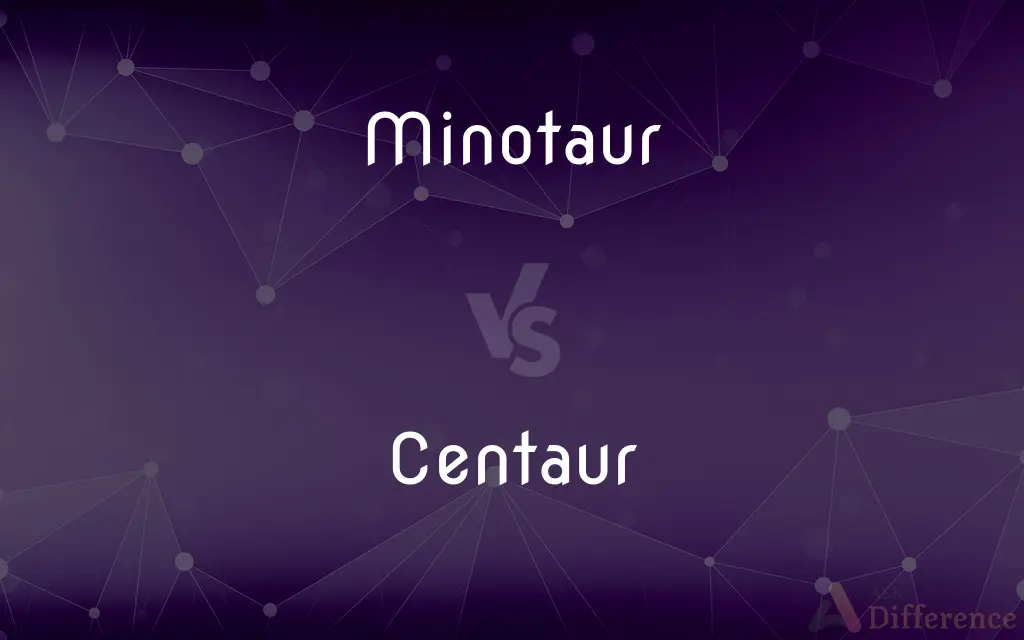Minotaur vs. Centaur — What's the Difference?
Edited by Tayyaba Rehman — By Fiza Rafique — Updated on September 26, 2023
Minotaur is creature with a human body and a bull's head. Centaur is a being with a human upper body and horse's lower body.

Difference Between Minotaur and Centaur
Table of Contents
ADVERTISEMENT
Key Differences
The Minotaur is a creature from Greek mythology with the body of a man and the head of a bull. In contrast, the Centaur, also from Greek myth, combines the upper body of a human with the lower body of a horse.
Minotaur's most famous tale involves the Labyrinth of Crete, where it was kept and to which youths were sacrificed. On the other side, Centaurs are often depicted in mythological stories as wild and unruly, sometimes engaging in battles with humans.
While the Minotaur represents the beastly and monstrous side of humanity, trapped within the confines of the Labyrinth, Centaurs often symbolize the duality of man’s nature, being both civilized and wild.
Comparison Chart
Origin
Greek Mythology
Greek Mythology
Physical Features
Human body with a bull's head
Human upper body, horse's lower
ADVERTISEMENT
Primary Tale
Trapped in the Labyrinth
Encounters with heroes
Symbolism
Beastly, monstrous side of man
Duality of human nature
Associated Place
Crete
Various locations in Greece
Compare with Definitions
Minotaur
An antagonist in ancient Cretan tales.
Theseus defeated the Minotaur, saving many lives.
Centaur
A mythological being blending man and horse.
The Centaur aimed his bow, skilled in both human and equine strengths.
Minotaur
A symbol of the monstrous within humanity.
The Minotaur's confinement mirrored our own inner battles.
Centaur
A symbol of mankind's dual nature.
Like a Centaur, he felt torn between two worlds.
Minotaur
A creature of King Minos's creation.
The Minotaur was a curse upon King Minos and his people.
Centaur
Featured in tales with Greek heroes like Hercules.
The Centaur became a challenge Hercules had to face.
Minotaur
A mythical creature with a man's body and a bull's head.
The Minotaur roamed the Labyrinth, waiting for its next victim.
Centaur
Often portrayed as wild and untamed in myths.
The Centaur's wild nature led to many confrontations.
Minotaur
In Greek mythology, the Minotaur ( MY-nə-TOR, MIN-ə-TOR, US: MIN-ə-TAR, -oh-; Ancient Greek: Μινώταυρος [miːnɔ̌ːtau̯ros]; in Latin as Minotaurus [miːnoːˈtau̯rʊs]) is a mythical creature portrayed in Classical times with the head and tail of a bull and the body of a man or, as described by Roman poet Ovid, a being "part man and part bull". He dwelt at the center of the Labyrinth, which was an elaborate maze-like construction designed by the architect Daedalus and his son Icarus, on the command of King Minos of Crete.
Centaur
Represents the meeting of civilization and wilderness.
The Centaur embodied the balance between culture and instinct.
Minotaur
A monster who was half man and half bull, to whom young Athenian men and women were sacrificed in the Cretan labyrinth until Theseus killed him.
Centaur
A centaur (; Ancient Greek: κένταυρος, kéntauros, Latin: centaurus), or occasionally hippocentaur, is a creature from Greek mythology with the upper body of a human and the lower body and legs of a horse.Centaurs are thought of in many Greek myths as being as wild as untamed horses, and were said to have inhabited the region of Magnesia and Mount Pelion in Thessaly, the Foloi oak forest in Elis, and the Malean peninsula in southern Laconia. Centaurs are subsequently featured in Roman mythology, and were familiar figures in the medieval bestiary.
Minotaur
(Greek mythology) Minotaur
Centaur
Greek Mythology One of a race of monsters having the head, arms, and trunk of a man and the body and legs of a horse.
Minotaur
Anything resembling the Greek monster, whether by appearance or by strength.
Centaur
(Astronomy) Any of a group of icy asteroids that orbit the sun primarily in the region between Jupiter and Neptune, whose orbits they cross. Some centaurs appear to be more like comets than asteroids.
Minotaur
A fabled monster, half man and half bull, confined in the labyrinth constructed by Dædalus in Crete.
Centaur
(Greek mythology) A mythical beast having a horse's body with a man's head and torso in place of the head and neck of the horse.
Minotaur
(Greek mythology) a mythical monster with the head of a bull and the body of a man; slain by Theseus
Centaur
An icy planetoid that orbits the Sun between Jupiter and Neptune.
Minotaur
A tragic figure representing entrapment.
Like the Minotaur, he felt trapped in his circumstances.
Centaur
(chess) A chess-playing team comprising a human player and a computer who work together.
Centaur
A fabulous being, represented as half man and half horse.
Centaur
A constellation in the southern heavens between Hydra and the Southern Cross.
Centaur
(classical mythology) a mythical being that is half man and half horse
Centaur
A conspicuous constellation in the southern hemisphere near the Southern Cross
Common Curiosities
Where does the legend of the Minotaur come from?
The legend originates from Crete and its King Minos.
What is a Centaur?
A Centaur is a mythological being with a human upper body and the lower body of a horse.
How did Theseus relate to the Minotaur?
Theseus is known for navigating the Labyrinth and defeating the Minotaur.
What do Centaurs symbolize?
They often symbolize the duality of human nature, both civilized and wild.
Are Centaurs considered good or evil in mythology?
They're portrayed in diverse ways; sometimes wild and unruly, at other times wise and noble.
Are there any famous Centaurs in mythology?
Yes, Chiron is a famous Centaur known for his wisdom and medicinal skills.
What is a Minotaur?
A Minotaur is a creature from Greek mythology with the body of a man and the head of a bull.
Was the Minotaur a god?
No, the Minotaur was a creature, not a god.
Why was the Minotaur kept in a Labyrinth?
It was kept there by King Minos to contain its monstrous nature and as a form of punishment.
Share Your Discovery

Previous Comparison
Prophetical vs. Prophetic
Next Comparison
Requirement vs. DemandAuthor Spotlight
Written by
Fiza RafiqueFiza Rafique is a skilled content writer at AskDifference.com, where she meticulously refines and enhances written pieces. Drawing from her vast editorial expertise, Fiza ensures clarity, accuracy, and precision in every article. Passionate about language, she continually seeks to elevate the quality of content for readers worldwide.
Edited by
Tayyaba RehmanTayyaba Rehman is a distinguished writer, currently serving as a primary contributor to askdifference.com. As a researcher in semantics and etymology, Tayyaba's passion for the complexity of languages and their distinctions has found a perfect home on the platform. Tayyaba delves into the intricacies of language, distinguishing between commonly confused words and phrases, thereby providing clarity for readers worldwide.














































